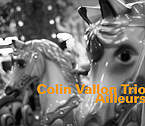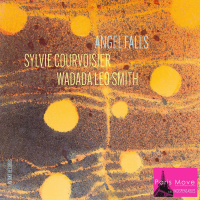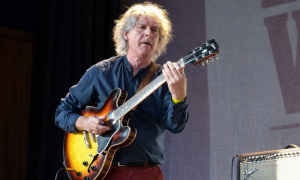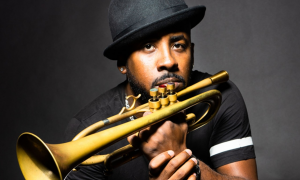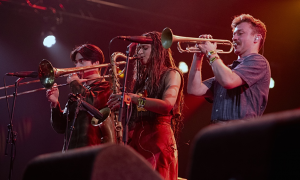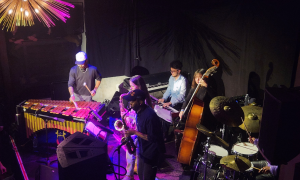Home » Jazz Articles » Live Review » Portland Jazz Festival Day 3: February 18, 2007
Portland Jazz Festival Day 3: February 18, 2007
Roundtable Discussion: The Myth of the ECM Sound
The final day of the Portland Jazz Festival's opening weekend also featured the last of three roundtable discussions about ECM Records. The subject was "The Myth of the ECM Sound"—with a large group of participants, including ECM's Steve Lake, writer/moderator Howard Mandel, publicist Don Lucoff, writers Neil Tesser and Josef Woodard, writer/audiophile expert Thomas Conrad, writer/studio engineer Larry Appelbaum, and yours truly. The stage was set for some serious debunking of the myth.
After an introduction that attempted to dispel common misconceptions about ECM—that there are stock technical approaches like microphone placement, reverb settings and other post-production techniques—what became clear as the discussion progressed was that ECM does have an identifiable sound, but it's more expansive than any narrow definition. Transparency, clarity and nuance were among the common terms bantered about.
One source of disagreement that occurred throughout the weekend was whether or not the ECM sound is "cold." Another was the subject of the label's broader soundscapes, which rarely emulate the gritty sound one might hear in a club. But through discussion of contentious issues like these, a clearer picture of the label's identity emerged.
A particularly clear moment came in comparing ECM's New Series releases of classical material to the same material found on other labels where less attention is paid to the clarity of sound. Equally, in the jazz realm, comparisons between recordings by pianist Keith Jarrett's American Quartet of the 1970s on Impulse! and ECM helped create a clear distinction. One may prefer the performances by the quartet on Impulse!, but it's difficult to deny that the ECM recordings sound better.
Another distinguishing characteristic that not only defines the label, but also provides a link between the New Series and regular series, is that even with the classical recordings, Manfred Eicher is looking for the single best performance, as opposed to using digital editing software like ProTools to piece together the "perfect" performance from a series of different takes.
A common thread that emerged throughout the weekend was that there can be great power in silence. The power of nuance can be just as moving as the viscerally frenetic. Last, the very fact that ECM now records in a number of different studios and church halls (not to mention live concert venues) with a variety of engineers would lay waste to any claim of a single specific approach.
Tomasz Stańko Quartet
An afternoon double-bill of Polish trumpeter Tomasz Stanko's quartet and American woodwind multi-instrumentalist Charles Lloyd's quartet brought a strong close to the ECM theme of the 2007 Portland Jazz Festival by presenting two groups that couldn't be more different— yet, underneath it all, shared more in common than one might think.
Over the past five years, beginning with Soul of Things (ECM, 2002), Stanko's group of young Polish players has shown remarkable growth. With each successive album—Suspended Night (ECM, 2004) and Lontano (ECM, 2006)—pianist Marcin Wasilewski, bassist Slawomir Kurkiewicz and drummer Michel Miskiewicz have become more intimately in tune with themselves and Stanko, and more capable of approaching the trumpeter's music with greater freedom. Lontano was their most liberated effort yet; over half the album consisted of three lengthy spontaneous explorations.
While the group's performance was focused on material from Lontano and there was plenty of freedom in evidence, the quartet grooved harder than on record. The music began in abstraction, but ultimately found its way into a groove not unlike that of Miles Davis' classic "All Blues." Still, despite firm pulses throughout most of the set, the growth which was evident on the record has been realized to an even greater extent now, fifteen months and many performances later.
Wasilewski has begun shedding influences, once worn on his sleeve but now subsumed within an emerging, more personal voice. Comparing Wasilewski with Diego Ramirez (who performed the previous day), he manifests a greater maturity, and the mark of a pianist with nothing to prove. Kurkiewicz and Miskiewicz also share this kind of confidence. In the early days of Soul of Things, the bassist and drummer more commonly assumed a support role. Now they're taking increasing liberties with their solo opportunities, and the overall feeling is that this is now a group of equals.
In the early part of the performance, Stanko's normally raspy tone was soft and round. But as the set progressed and the energy picked up, his edge began to return. As a soloist Stanko continues to be concerned with finding greater depth in melancholy lyricism, but an optimism also seems to be peering out through the darkness now and then. Like Enrico Rava—another ECM trumpeter with whom he's sometimes compared—Stanko seems to be more inclined towards bringing in elements of the conventional jazz tradition like swing, although this music could hardly be described as conventional.
Whether in the context of a rubato tone poem or a more fervent pulse, there was nothing superfluous in this set by Stanko's quartet— instead, an understated power defined by grace and nuance. Stanko, as well as his bandmates, does more than make his instrument sing; he uses it to evoke a broad range of emotions from joy to pain.
Charles Lloyd Quartet
Following a thirty-minute intermission, Charles Lloyd and his quartet took the stage with a lengthy take on the traditional "Go Down Moses," from Lift Every Voice (ECM, 2002). Of his other bandmembers, only pianist Geri Allen performed on that recording, but drummer Eric Harland has been working with Lloyd for a couple of years, and he played on last year's spiritual Sangam (ECM). Only bassist Reuben Rogers is relatively new, but alongside Harlan, the two made for a vivid rhythm section that, together with Allen, may well be the best quartet mates of Lloyd's long career.
Lloyd may be prone to rambling words, and he's been known to wax on a bit during his solos, but here he played with great focus and surprising concision. On tenor he would occasionally create flurries of notes reminiscent of John Coltrane's sheets of sound, but his delivery has always been (and remains) softer and less jagged. Lloyd focused on tenor for the majority of the performance, but he also brought out his flute for one piece and the Hungarian taragato for another.
As strong as Allen's performance with her own trio was the previous day, this group demonstrated a "take no prisoners" approach. The pianist seemed to take more risks, her unfettered solos of cascading notes and powerful chords becoming more instinctively connected with the rest of the group, especially Harland, who was like a force of nature.
Harland managed to bring together conventional swing and a taste of urban rhythms, making the entire group feel timeless yet completely contemporary. Despite a clear rhythmic focus, he was a melodically inventive soloist, with a polyrhythmic strength that had to be seen to be believed.
Rogers played with a visceral energy, his body an extension of his instrument. He was also clearly enjoying himself, grinning from ear to ear for most of the performance. His tone was equally physical, but it didn't take away from his ability to play with gentle elegance when the need arose.
Hearing the quartet play "Sweet Georgia Bright," after Allen played it with her trio the previous day, highlighted what a difference a rhythm section can make. It's not a matter of better or worse, just different. Lloyd's take on the tune was bristling with an almost unbridled energy.
When he wasn't playing, Lloyd stood towards the back of the stage, clearly captivated by the performance of his group. He may be approaching seventy, but in many ways he's playing the most vital music of his career. He may be walking a little slower, but if anything his playing has intensified relative to the more atmospheric spirituality of some of his earlier (but equally fine) ECM recordings with bassist Anders Jormin and pianist Bobo Stenson.
While there are seven more days left to the 2007 Portland Jazz Festival, this day was the end of the ECM signature. Kudos go out to Artistic Director Bill Royston, Managing Director Sarah Bailen Smith and the entire PDX Jazz crew for putting on a festival that is world-class in stature, but open and inviting in tone. This may only be PDX Jazz's fourth year, but the festival has a great future ahead of it.
Photo Credit: John Kelman
Tags
Tomasz Stanko Quartet; Charles Lloyd
Live Reviews
John Kelman
Michael Bloom Media Relations
United States
PREVIOUS / NEXT
Support All About Jazz
 All About Jazz has been a pillar of jazz since 1995, championing it as an art form and, more importantly, supporting the musicians who make it. Our enduring commitment has made "AAJ" one of the most culturally important websites of its kind, read by hundreds of thousands of fans, musicians and industry figures every month.
All About Jazz has been a pillar of jazz since 1995, championing it as an art form and, more importantly, supporting the musicians who make it. Our enduring commitment has made "AAJ" one of the most culturally important websites of its kind, read by hundreds of thousands of fans, musicians and industry figures every month.


